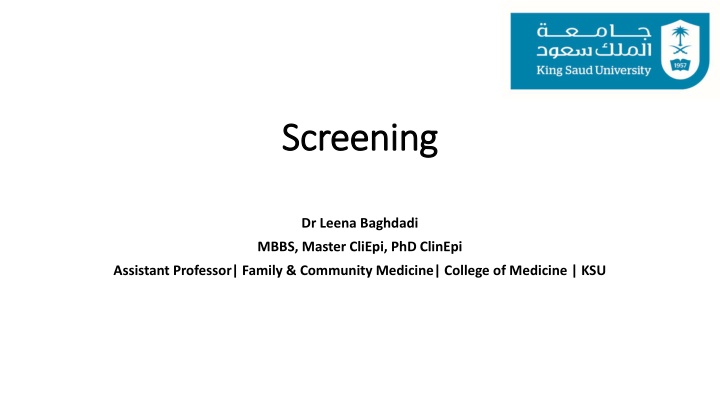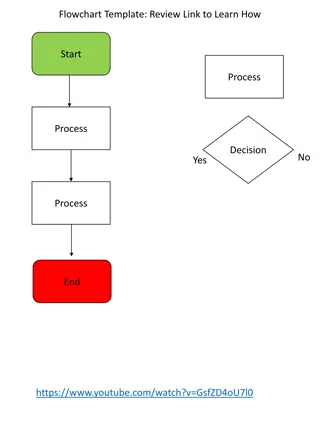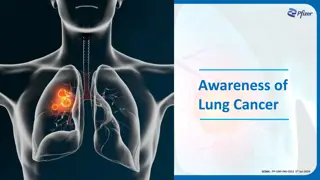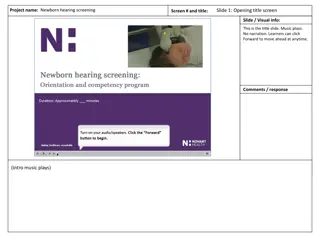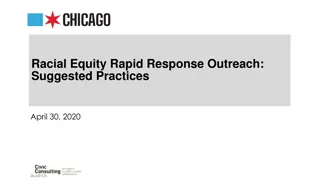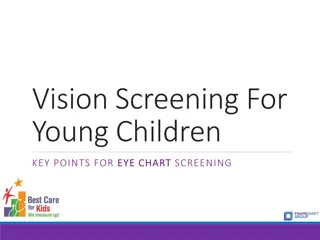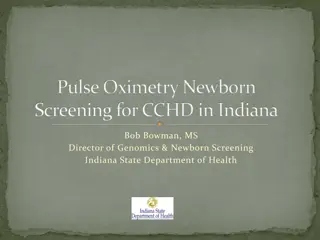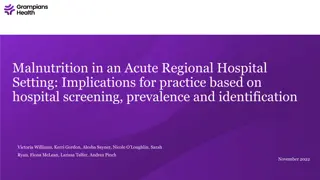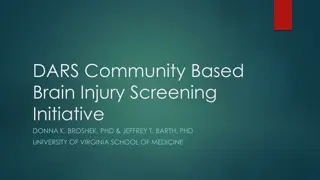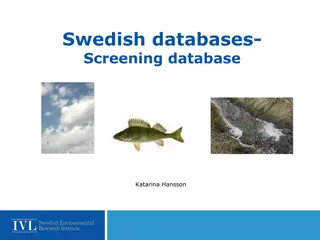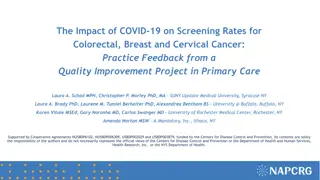Screening: Definition, Tools, and Concepts
"Screening plays a crucial role in healthcare by actively searching for unrecognized diseases in apparently healthy individuals. This content delves into the definition, tools, and concepts of screening, including the differences between screening, case finding, periodic examination, and diagnosis. It covers the objectives, validity of screening tests, and criteria for ideal screening tests. Explore the importance of sensitivity, specificity, positive predictive value, and more in screening programs."
Download Presentation

Please find below an Image/Link to download the presentation.
The content on the website is provided AS IS for your information and personal use only. It may not be sold, licensed, or shared on other websites without obtaining consent from the author.If you encounter any issues during the download, it is possible that the publisher has removed the file from their server.
You are allowed to download the files provided on this website for personal or commercial use, subject to the condition that they are used lawfully. All files are the property of their respective owners.
The content on the website is provided AS IS for your information and personal use only. It may not be sold, licensed, or shared on other websites without obtaining consent from the author.
E N D
Presentation Transcript
Screening Screening Dr Leena Baghdadi MBBS, Master CliEpi, PhD ClinEpi Assistant Professor| Family & Community Medicine| College of Medicine | KSU
Objectives Definition of screening Concept of screening and the lead time Difference between screening , case finding , periodic examination and diagnosis Uses of screening programs Criteria of health problems amenable for screening Differences between screening and diagnostic test Distinguish between mass screening and high risk screening Criteria of an ideal screening test 01/03/2018 Dr L. Baghdadi_ Screening 2
Cont. objectives Validity of screening test and its calculations: 1. Sensitivity 2. Specificity 3. Positive predictive value 4. Negative predictive value 5. False Positive Rate 6. False Negative Rate 01/03/2018 Dr L. Baghdadi_ Screening 3
1. Definition of screening Screening: actively searching for unrecognized disease or defect by means of rapidly applied tools in apparently healthy individuals not seeking medical care 01/03/2018 Dr L. Baghdadi_ Screening 4
Tools and examples of screening 01/03/2018 Dr L. Baghdadi_ Screening 5
2. Concept of Screening Table 1. Natural history of disease and levels of prevention 01/03/2018 Dr L. Baghdadi_ Screening 6
3. Concept of Lead Time Figure 1. Model for early detection program 01/03/2018 Dr L. Baghdadi_ Screening 7
4. Table 2. Difference between screening, case finding, periodic examination and diagnosis Screening Periodic examination Case finding Diagnosis The search for unrecognized disease or defect by means of rapidly applied tools in apparently healthy individuals not seeking medical care. Seeking of medical care at intervals to evaluate health status and to detect any health problem without the presence of any complaint. In periodic examination, different systems are looked at and a series of investigations are applied. The use of a clinical, laboratory or non laboratory test to detect disease in individuals seeking health care for other reasons. The aim of identifying diabetes among pregnant women is an example of case finding. A procedure to confirm or refute the existence of a disease or abnormality among those seeking medical care with a specific complaint. Achieved by obtaining medical history, clinical examination and the application of laboratory or non laboratory tests. 01/03/2018 Dr L. Baghdadi_ Screening 8
5. Uses of screening programs Table 3. Uses of screening tests No. Use of screening program Definition Prescriptive screening Identification of unrecognized disease or defect that doesn t arise from patients request Example 1 Case detection Neonatal screening 2 Control of diseases Prospective screening Prevention of the transmission of the disease to healthy community members Screening of immigrants from infectious diseases such as tuberculosis and syphilis 3 Research purposes Initial screening is conducted to estimate the prevalence of a disease and subsequent screening will provide data on the incidence Screening of chronic diseases whose natural history is not fully known (e.g. cancer) 01/03/2018 Dr L. Baghdadi_ Screening 9
6. Types of screening programs 1. Mass screening: Applied to the whole population or population subgroups as adults, school children, industrial s workers irrespective of their risk. 01/03/2018 Dr L. Baghdadi_ Screening 10
2. High risk or selective screening: Applied to a selective population subgroups who are at a high risk. Among high risk population, the disease is more likely to be prevalent and the screening will result in a better yield. 01/03/2018 Dr L. Baghdadi_ Screening 11
7. Criteria of screening It is related to: A. The disease B. The screening test 01/03/2018 Dr L. Baghdadi_ Screening 12
A. The disease The disease to be screened should fulfil the following criteria before it is considered suitable for screening: 1.The condition sought should be an important health (in general, prevalence should be high) 01/03/2018 Dr L. Baghdadi_ Screening 13
2. There should be a recognizable latent or early asymptomatic stage 01/03/2018 Dr L. Baghdadi_ Screening 14
3. The natural history of the condition, including development from latent to declared disease, should be adequately understood (so that we can know at what stage the process ceases to be reversible) 01/03/2018 Dr L. Baghdadi_ Screening 15
4. There is a test that can detect the disease prior to the onset of signs and symptoms 01/03/2018 Dr L. Baghdadi_ Screening 16
5. Facilities should be available for confirmation of the diagnosis 01/03/2018 Dr L. Baghdadi_ Screening 17
6. There is an effective treatment 01/03/2018 Dr L. Baghdadi_ Screening 18
7. There is good evidence that early detection and treatment reduces morbidity and mortality 01/03/2018 Dr L. Baghdadi_ Screening 19
8. The expected benefits (e.g., the number of lives saved) of early detection exceed the risks and costs 01/03/2018 Dr L. Baghdadi_ Screening 20
Screening and diagnostic test Table 4. Difference between screening and diagnostic test No. Screening test Diagnostic test 1 Done on apparently healthy Done on those with indications or sick 2 Applied to groups Applied to single patients, all diseases are considered 3 Test results are arbitrary and final Diagnosis is not final but modified in light of new evidence, diagnosis is the sum of all evidence 4 Based on one criterion or cut-off point Based on evaluation of a number of symptoms, signs (e.g., diabetes) and laboratory findings 5 Less accurate More accurate 6 Less expensive More expensive 7 Not a basis for treatment Used as a basis for treatment 8 The initiative comes from the investigator or agency providing care The initiative comes from a patient with a complaint 01/03/2018 Dr L. Baghdadi_ Screening 21
7. Cont. Criteria of screening It is related to: A. The disease B. The screening test 01/03/2018 Dr L. Baghdadi_ Screening 22
B. The Screening Test 1. Feasibility: Simple, inexpensive, capable of wide application 2. Acceptability: Acceptable by the people to whom it is intend to be applied 3. Reliability (precision): Consistent results on repeated application on the same individual under same circumstances 4. Validity (accuracy): Ability to distinguish between those who have and those who don t have the disease as confirmed by a gold standard 01/03/2018 Dr L. Baghdadi_ Screening 23
8. Validity of screening test 1. Sensitivity: ability of the test to detect correctly those who truly have the condition (true positive) 2. Specificity: ability of the test to detect correctly those who truly do not have the condition (true negative) 01/03/2018 Dr L. Baghdadi_ Screening 24
1. Sensitivity It is called as true positive rate. True Positive Rate Percentage of patients who have a disease that test positive on the test. Sensitivity= True positive/T Disease 100 01/03/2018 Dr L. Baghdadi_ Screening 25
2. Specificity It is called the true negative rate. True Negative Rate Percentage of patients who do not have the disease who test negative on the test. Specificity= True Negative/ T Non-Disease 100 01/03/2018 Dr L. Baghdadi_ Screening 26
3. False Positive Rate Percentage of patients who have a positive test result but do not have the disease. 01/03/2018 Dr L. Baghdadi_ Screening 27
4. False Negative Rate Percentage of patients who have negative test results but have the disease. 01/03/2018 Dr L. Baghdadi_ Screening 28
False negative result False positive result 1. is referred to as adverse effect or errors of screening is not desirable 2. is a waste of resources; incurring the cost of the screening and the confirmation of the diagnosis 3. leads to unnecessary exposure of subjects to the hazards of the tests 4. causes emotional strain of being a probable case 1. is not desirable 2. gives a false re-assurance that they are free from the condition 01/03/2018 Dr L. Baghdadi_ Screening 29
Truth Sensitivity= A/(A+C) 100 Disease (number) Non-Disease (number) Total (number) Specificity= D/(D+B) 100 Positive (number) A B T Test Positive Test Result (True Positive) (False Positive) False Positive Rate= B /(B+D) 100 Negative (number) C D T Test Negative (False Negative) (True Negative) T Disease T Non-Disease Total False Negative Rate= C /(A+C) 100 01/03/2018 Dr L. Baghdadi_ Screening 30
Example Example Breast cancer Total Test Positive 900 100 1000 Negative 1980 97020 99000 Positive Negative Total Sensitivity= A/(A+C) 100 (900/1000)x 100 = 90.00% Specificity= D/(D+B) 100 (97020/99000) x 100 = 98.00% 2880 97120 100000 (1980/99000) x100= 2% False Negative Rate= C /(A+C) 100 (100/1000) x100= 10% False Positive Rate= B /(B+D) 100 01/03/2018 Dr L. Baghdadi_ Screening 31
Interpretations of sensitivity and specificity: Breast cancer screening test was capable to identify correctly 90% of the those who have the cancer Breast cancer screening test was capable to identify correctly 98% of the those who don t have the condition 01/03/2018 Dr L. Baghdadi_ Screening 32
5. Positive predictive value Percentage of the time that a positive test correctly identifies people who have the disease. Positive Predictive Value= True Positive/ T Test Positive 100 01/03/2018 Dr L. Baghdadi_ Screening 33
6. Negative predictive value Percentage of time that a negative test correctly identifies people without the disease. Negative Predictive Value= True Negative/ T Test Negative 100 01/03/2018 Dr L. Baghdadi_ Screening 34
Meaning of positive predictive value Reflects the diagnostic power of the test. The predictive accuracy depends upon sensitivity, specificity and disease prevalence Low value is a waste of resources; very few of those who tested positive will be found to have the condition High value is desirable in screening program; detecting and bringing into care subjects with the condition at a pre-clinical stage 01/03/2018 Dr L. Baghdadi_ Screening 35
Truth Positive Predictive Value= A/(A+B) 100 Disease (number) Non-Disease (number) Total (number) Positive (number) A B T Test Positive Negative Predictive Value= D/(D+C) 100 Test Result (True Positive) (False Positive) Negative (number) C D T Test Negative (False Negative) (True Negative) T Disease T Non-Disease Total 01/03/2018 Dr L. Baghdadi_ Screening 36
Example Example Breast cancer Total Test Positive 900 100 1000 Negative 1980 97020 99000 Positive Negative Total Positive Predictive Value= A/(A+B) 100 (900/2880) x 100 = 31.3% Out of those who are positive by the test only 31.3% are found to have breast cancer 2880 97120 100000 Negative Predictive Value= D/(D+C) 100 (97020/97120) x 100 = 99.9% Out of those who are negative by the test, 99.9% are found to be free from the cancer 01/03/2018 Dr L. Baghdadi_ Screening 37
Thank you Thank you
